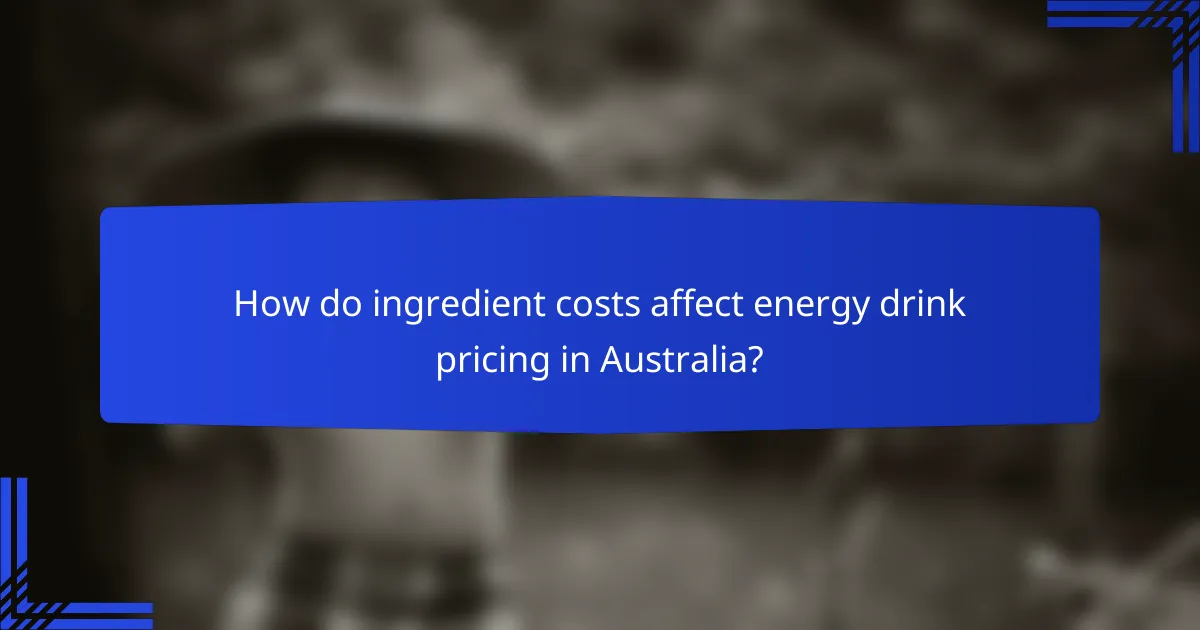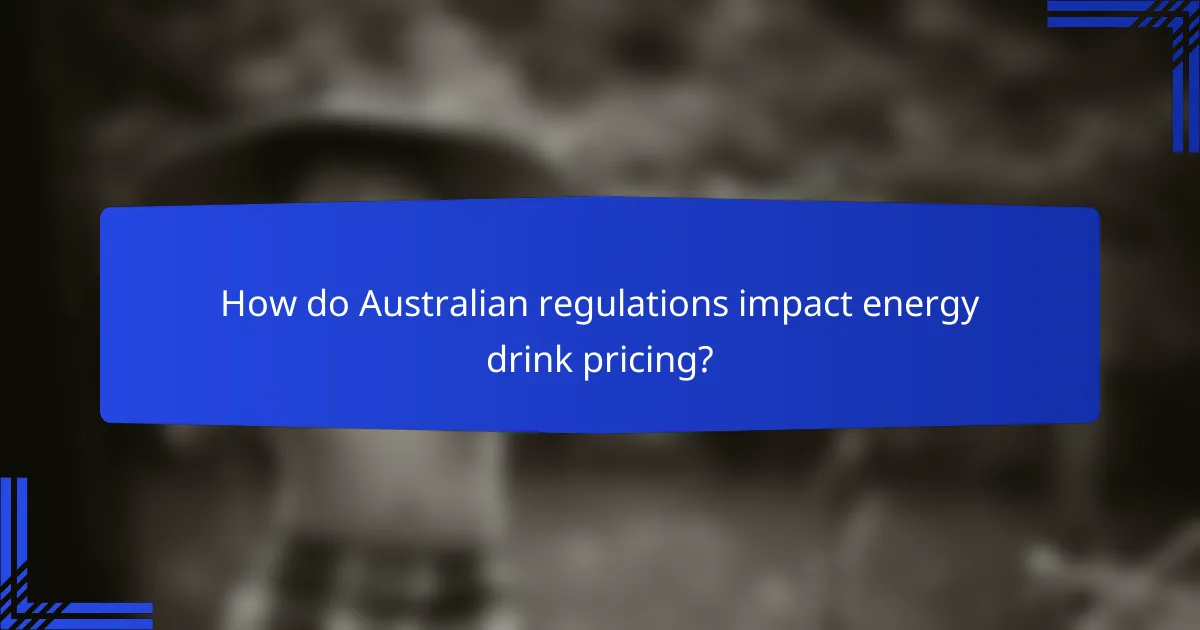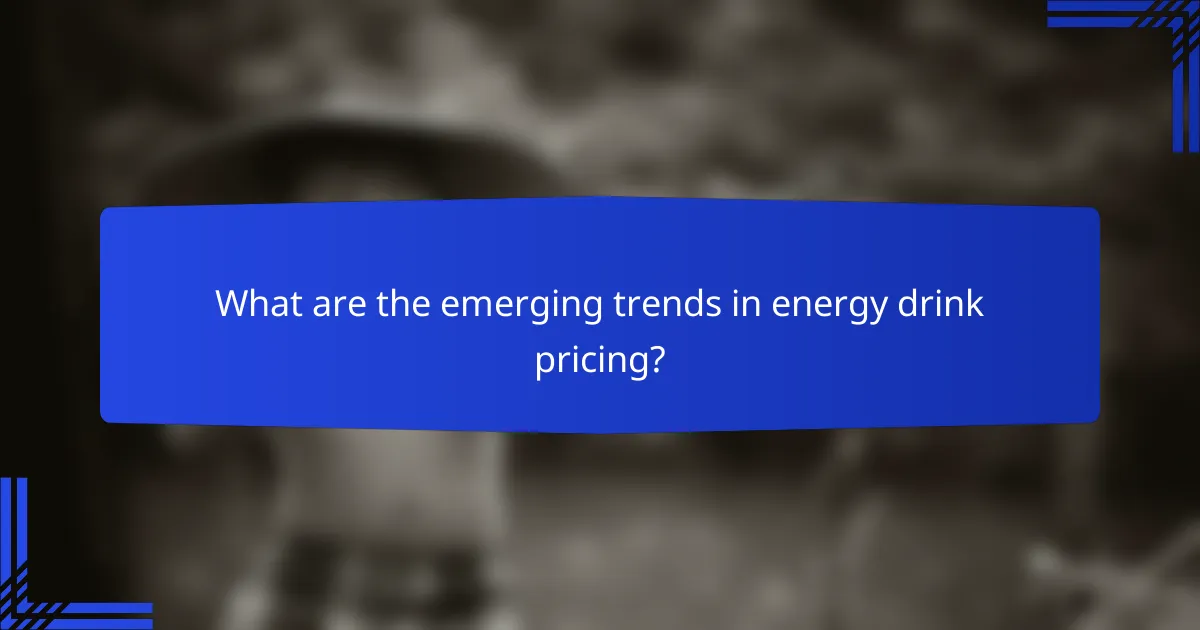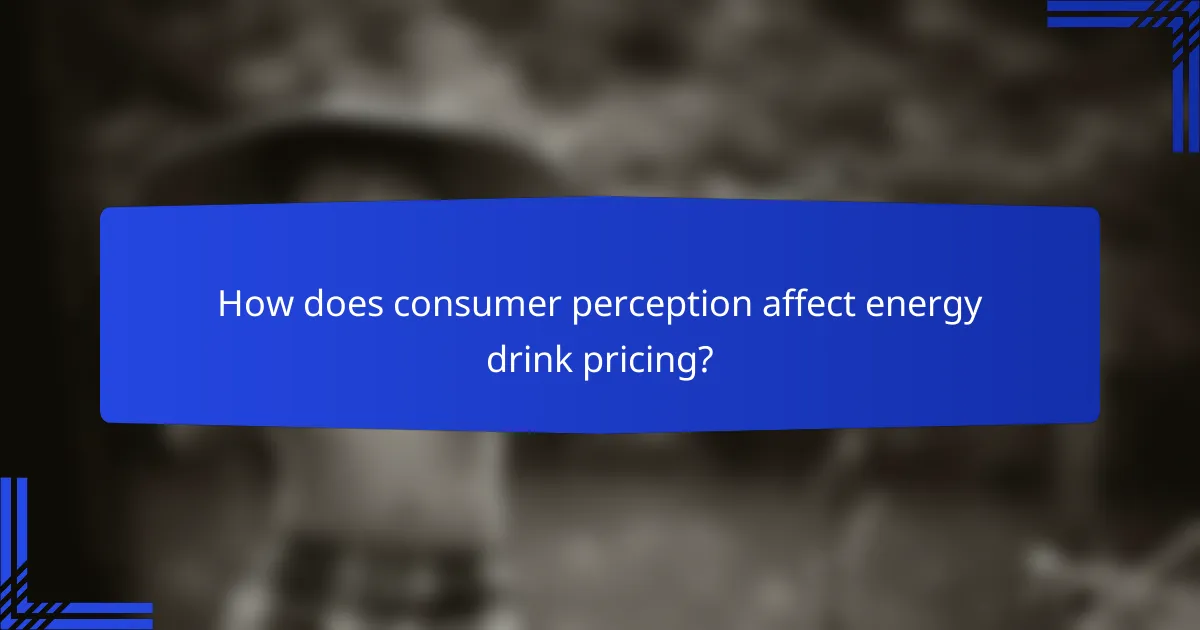The pricing of energy drinks is heavily influenced by ingredient costs, as the quality and sourcing of these components directly impact production expenses. In a competitive market, leading brands employ unique branding strategies to establish strong identities, often focusing on lifestyle marketing and target demographics. Additionally, market competition drives brands to adjust their pricing in response to rivals, which can lead to price wars that benefit consumers while challenging manufacturers’ profit margins.

How do ingredient costs affect energy drink pricing in Australia?
Ingredient costs play a significant role in determining the pricing of energy drinks in Australia. The quality and source of ingredients directly influence production expenses, which are then reflected in retail prices.
Raw material expenses
Raw material expenses encompass the costs of essential ingredients like caffeine, taurine, and various vitamins. Prices for these materials can fluctuate based on market demand and availability, impacting overall pricing strategies. For instance, if the cost of caffeine rises due to supply chain issues, manufacturers may increase their product prices to maintain profit margins.
Additionally, premium ingredients, such as organic or sustainably sourced components, can further elevate raw material costs. Brands that emphasize high-quality ingredients often price their products higher to reflect these expenses.
Production costs
Production costs include expenses related to manufacturing, packaging, and labor. In Australia, energy drink producers must comply with strict food safety regulations, which can add to production costs. Efficient production processes can help mitigate these expenses, but any inefficiencies can lead to increased prices for consumers.
Moreover, the scale of production affects unit costs. Larger manufacturers may benefit from economies of scale, allowing them to offer competitive pricing compared to smaller brands that face higher per-unit costs.
Ingredient sourcing
Ingredient sourcing involves selecting suppliers and negotiating prices for raw materials. Local sourcing can reduce transportation costs and support Australian farmers, but it may limit ingredient availability or variety. Conversely, sourcing ingredients from international suppliers can provide access to a broader range of materials but may introduce additional shipping costs and tariffs.
Brands must balance the benefits of local versus international sourcing to manage costs effectively. Establishing strong relationships with suppliers can lead to better pricing and more reliable ingredient availability, ultimately influencing the final retail price of energy drinks.

What are the branding strategies of leading energy drink companies?
Leading energy drink companies utilize distinct branding strategies to differentiate themselves in a competitive market. These strategies often focus on lifestyle marketing, target demographics, and unique product positioning to create strong brand identities.
Brand positioning of Red Bull
Red Bull positions itself as a premium energy drink that embodies an adventurous and active lifestyle. The brand is synonymous with extreme sports and high-energy events, which reinforces its image as a drink for those seeking excitement and performance.
This positioning is supported by strategic sponsorships and marketing campaigns that target young, active consumers. Red Bull’s tagline, “Red Bull gives you wings,” encapsulates its promise of enhanced energy and performance, appealing to its core audience.
Marketing tactics of Monster Energy
Monster Energy employs aggressive marketing tactics that focus on grassroots engagement and community-building. The brand sponsors a wide array of events, from music festivals to extreme sports competitions, fostering a loyal fan base that identifies with its edgy image.
Additionally, Monster utilizes bold packaging and a diverse product range to attract various consumer segments. Its marketing often emphasizes the drink’s high caffeine content and unique flavors, appealing to those looking for a robust energy boost.

How does market competition influence energy drink pricing?
Market competition significantly affects energy drink pricing by driving brands to adjust their prices based on rivals’ strategies. This dynamic can lead to price wars, which may benefit consumers but can also squeeze profit margins for manufacturers.
Price wars among brands
Price wars occur when competing energy drink brands lower their prices to attract more customers. This aggressive pricing strategy can lead to temporary discounts, making products more affordable for consumers. However, prolonged price wars can harm brand value and profitability, forcing companies to cut costs elsewhere, such as in ingredient quality or marketing efforts.
For instance, if a popular brand reduces its price to gain market share, other brands may feel pressured to follow suit, resulting in a downward spiral of prices. Consumers may benefit in the short term, but the long-term effects on brand loyalty and product quality can be detrimental.
Market share analysis
Understanding market share is crucial for energy drink companies as it directly influences pricing strategies. Brands with a larger market share can often afford to maintain higher prices due to established customer loyalty and brand recognition. Conversely, smaller brands may need to adopt competitive pricing to gain traction in the market.
For example, a leading energy drink brand might hold a market share of around 30-40%, allowing it to set premium prices. In contrast, newer entrants might price their products lower, around 1-2 USD per can, to entice consumers away from established brands. This competitive landscape requires ongoing analysis to adapt pricing strategies effectively.

What are the key factors in energy drink pricing strategies?
Energy drink pricing strategies are influenced by ingredient costs, branding efforts, and market competition. Companies must balance these factors to set prices that attract consumers while maintaining profitability.
Consumer demand trends
Consumer demand trends play a crucial role in shaping energy drink pricing. As health consciousness rises, brands are increasingly focusing on natural ingredients and functional benefits, which can lead to higher production costs. Additionally, seasonal trends, such as increased sales during summer months or major sporting events, can affect pricing strategies.
Brands often conduct market research to understand consumer preferences and adjust their offerings accordingly. For instance, energy drinks marketed towards athletes may command higher prices due to the perceived value of performance-enhancing ingredients.
Retail markup practices
Retail markup practices significantly impact the final price consumers pay for energy drinks. Retailers typically apply a markup ranging from 30% to 50% on wholesale prices, depending on the product’s popularity and brand strength. High-demand brands may see even steeper markups, especially in convenience stores or gas stations.
Understanding these markup practices can help consumers identify the best places to purchase energy drinks. Buying in bulk or choosing less popular brands can often lead to savings, while promotional deals can also provide opportunities for cost-effective purchases.

How do Australian regulations impact energy drink pricing?
Australian regulations significantly influence energy drink pricing through strict labeling and health standards. These regulations can increase production costs, which are often passed on to consumers in the form of higher prices.
Labeling requirements
Energy drinks sold in Australia must adhere to specific labeling requirements set by Food Standards Australia New Zealand (FSANZ). Labels must clearly display ingredients, nutritional information, and any warnings related to caffeine content. This transparency helps consumers make informed choices but may increase marketing and compliance costs for manufacturers.
For example, energy drinks must indicate if they contain high levels of caffeine, which can lead to higher prices due to the need for detailed labeling and potential reformulation to meet these standards.
Health regulations
Health regulations in Australia impose restrictions on the sale and marketing of energy drinks, especially to minors. These regulations aim to protect public health but can limit market access and increase compliance costs for companies. As a result, manufacturers may raise prices to cover these expenses.
Additionally, energy drinks must meet specific safety and quality standards, which can involve rigorous testing and certification processes. These added costs often contribute to the overall pricing strategy of energy drinks in the Australian market.

What are the emerging trends in energy drink pricing?
Emerging trends in energy drink pricing reflect a growing emphasis on ingredient quality, branding strategies, and competitive market dynamics. As consumers become more health-conscious, the demand for premium products influences pricing structures significantly.
Shift towards natural ingredients
The shift towards natural ingredients in energy drinks is reshaping pricing strategies. Brands are increasingly incorporating organic components, such as natural caffeine sources and plant-based sweeteners, which can elevate production costs. This trend often results in higher retail prices, appealing to consumers willing to pay more for perceived health benefits.
For example, energy drinks featuring ingredients like green tea extract or guarana may be priced 10-30% higher than traditional options. Companies must balance ingredient quality with affordability to attract a broader customer base.
Impact of sustainability on pricing
Sustainability initiatives are becoming a significant factor in energy drink pricing. Brands that prioritize eco-friendly packaging and sustainable sourcing often incur additional costs, which can be reflected in their product prices. Consumers are increasingly supportive of these practices, sometimes willing to pay a premium for environmentally responsible products.
For instance, energy drinks packaged in recyclable materials or sourced from sustainable farms may see price increases of around 5-15%. Companies should communicate their sustainability efforts clearly to justify any price hikes and attract environmentally conscious consumers.

How does consumer perception affect energy drink pricing?
Consumer perception significantly influences energy drink pricing by shaping brand value and demand. Factors such as taste, effectiveness, and marketing strategies contribute to how consumers view a product, ultimately affecting how much they are willing to pay.
Ingredient Costs
The cost of ingredients plays a crucial role in determining the price of energy drinks. High-quality components like natural caffeine, vitamins, and herbal extracts can elevate production costs, which may be reflected in retail prices. Brands often balance ingredient quality with affordability to appeal to a broader audience.
For instance, energy drinks using organic or non-GMO ingredients may price higher than those with synthetic alternatives. Consumers who prioritize health and wellness may be more inclined to pay a premium for perceived benefits.
Branding
Branding significantly impacts energy drink pricing by establishing a product’s identity and perceived value. Strong branding can create a loyal customer base willing to pay more for a familiar label. Companies invest heavily in marketing to enhance brand recognition and differentiate themselves from competitors.
For example, brands that align themselves with extreme sports or high-energy lifestyles often command higher prices due to their targeted marketing strategies. This connection can justify a premium, as consumers associate the brand with specific experiences or values.
Market Competition
Market competition directly affects energy drink pricing as brands strive to capture consumer attention in a crowded marketplace. Companies must consider competitor pricing, product offerings, and promotional strategies when setting their prices. A competitive landscape can lead to price wars, impacting profit margins.
Brands may offer discounts or bundle deals to attract customers, especially in regions with numerous alternatives. Understanding local market dynamics is essential for pricing strategies, as consumer preferences and purchasing power can vary significantly across different areas.
